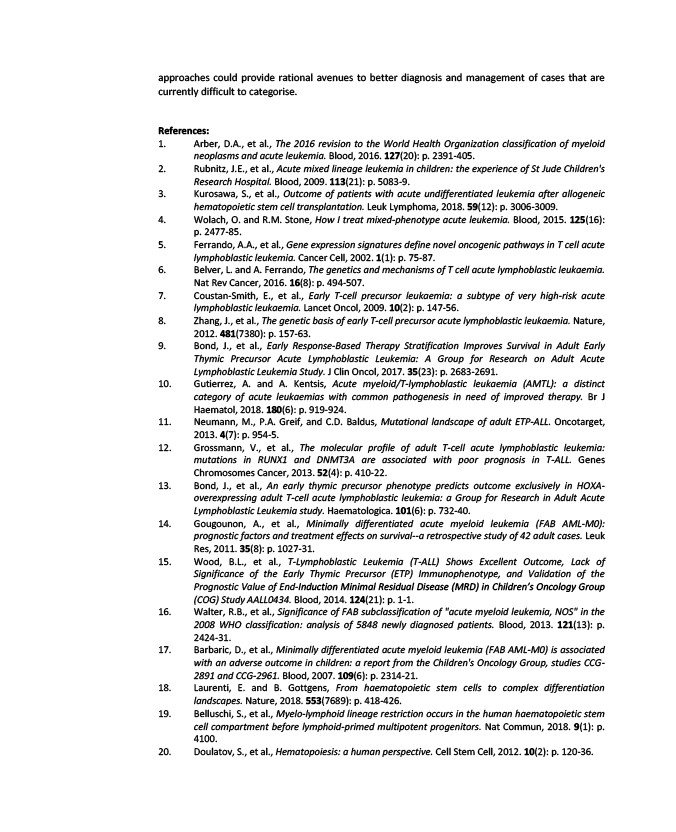
approaches could provide rational avenues to better diagnosis and management of cases that are
currently difficult to categorise.
References:
1. Arber, D.A., et al., The 2016 revision to the World Health Organization classification of myeloid
neoplasms and acute leukemia. Blood, 2016. 127(20): p. 2391-405.
2. Rubnitz, J.E., et al., Acute mixed lineage leukemia in children: the experience of St Jude Children's
Research Hospital. Blood, 2009. 113(21): p. 5083-9.
3. Kurosawa, S., et al., Outcome of patients with acute undifferentiated leukemia after allogeneic
hematopoietic stem cell transplantation. Leuk Lymphoma, 2018. 59(12): p. 3006-3009.
4. Wolach, O. and R.M. Stone, How I treat mixed-phenotype acute leukemia. Blood, 2015. 125(16):
p. 2477-85.
5. Ferrando, A.A., et al., Gene expression signatures define novel oncogenic pathways in T cell acute
lymphoblastic leukemia. Cancer Cell, 2002. 1(1): p. 75-87.
6. Belver, L. and A. Ferrando, The genetics and mechanisms of T cell acute lymphoblastic leukaemia.
Nat Rev Cancer, 2016. 16(8): p. 494-507.
7. Coustan-Smith, E., et al., Early T-cell precursor leukaemia: a subtype of very high-risk acute
lymphoblastic leukaemia. Lancet Oncol, 2009. 10(2): p. 147-56.
8. Zhang, J., et al., The genetic basis of early T-cell precursor acute lymphoblastic leukaemia. Nature,
2012. 481(7380): p. 157-63.
9. Bond, J., et al., Early Response-Based Therapy Stratification Improves Survival in Adult Early
Thymic Precursor Acute Lymphoblastic Leukemia: A Group for Research on Adult Acute
Lymphoblastic Leukemia Study. J Clin Oncol, 2017. 35(23): p. 2683-2691.
10. Gutierrez, A. and A. Kentsis, Acute myeloid/T-lymphoblastic leukaemia (AMTL): a distinct
category of acute leukaemias with common pathogenesis in need of improved therapy. Br J
Haematol, 2018. 180(6): p. 919-924.
11. Neumann, M., P.A. Greif, and C.D. Baldus, Mutational landscape of adult ETP-ALL. Oncotarget,
2013. 4(7): p. 954-5.
12. Grossmann, V., et al., The molecular profile of adult T-cell acute lymphoblastic leukemia:
mutations in RUNX1 and DNMT3A are associated with poor prognosis in T-ALL. Genes
Chromosomes Cancer, 2013. 52(4): p. 410-22.
13. Bond, J., et al., An early thymic precursor phenotype predicts outcome exclusively in HOXA-overexpressing
adult T-cell acute lymphoblastic leukemia: a Group for Research in Adult Acute
Lymphoblastic Leukemia study. Haematologica. 101(6): p. 732-40.
14. Gougounon, A., et al., Minimally differentiated acute myeloid leukemia (FAB AML-M0):
prognostic factors and treatment effects on survival--a retrospective study of 42 adult cases. Leuk
Res, 2011. 35(8): p. 1027-31.
15. Wood, B.L., et al., T-Lymphoblastic Leukemia (T-ALL) Shows Excellent Outcome, Lack of
Significance of the Early Thymic Precursor (ETP) Immunophenotype, and Validation of the
Prognostic Value of End-Induction Minimal Residual Disease (MRD) in Children’s Oncology Group
(COG) Study AALL0434. Blood, 2014. 124(21): p. 1-1.
16. Walter, R.B., et al., Significance of FAB subclassification of "acute myeloid leukemia, NOS" in the
2008 WHO classification: analysis of 5848 newly diagnosed patients. Blood, 2013. 121(13): p.
2424-31.
17. Barbaric, D., et al., Minimally differentiated acute myeloid leukemia (FAB AML-M0) is associated
with an adverse outcome in children: a report from the Children's Oncology Group, studies CCG-
2891 and CCG-2961. Blood, 2007. 109(6): p. 2314-21.
18. Laurenti, E. and B. Gottgens, From haematopoietic stem cells to complex differentiation
landscapes. Nature, 2018. 553(7689): p. 418-426.
19. Belluschi, S., et al., Myelo-lymphoid lineage restriction occurs in the human haematopoietic stem
cell compartment before lymphoid-primed multipotent progenitors. Nat Commun, 2018. 9(1): p.
4100.
20. Doulatov, S., et al., Hematopoiesis: a human perspective. Cell Stem Cell, 2012. 10(2): p. 120-36.